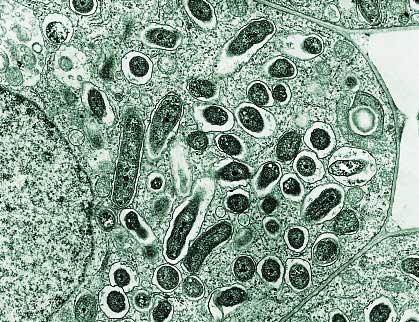The microscopic section of a nodule containing Rhizobium species is shown on the picture.
Rhizobium is a symbiotic nitrogen fixing bacterial genus. The species of Rhizobium genus form nodules in the plant roots and together with the plant are able to fix atmospheric nitrogen and convert it into amino acids and proteins.
The scene of the bacterial-plant symbiotic life and activities is the root, where bacteria are living in the nodules. The nitrogen-fixing activity of the nodules in legumines may substitute sythetic nitrogen supply (plant nutrient), which is ensured in present practice by nitrogen-fertilisers. Nitrogen fertilisers are not only costly but they endanger environment, pollute surface and subsurface waters, cause eutrofication in lakes and rivers as well as in the see.
The plant of pea, beans, clover and soy do live in symbiosis with Rhizobia.The legume–rhizobium symbiosis is a typical type of mutualism, what means that rhizobia supply ammonia or amino acids to the plant and in return plant supplies organic acids for the bacteria (e.g. dicarboxylic acids malate and succinate) as a carbon and energy source. It is also interesting, that many other bacteria (without supplying anything for the plant) take part in the cohabitation, exploiting its advantages but doing nothing for the common co-operation, paraziting the hostplant-bacteria symbiotic system. Plant tries to find the remedy for this kind of not mutual exploitation with different mechanisms. One type of solution are restrictions, e.g. reduced nodule growth or early nodule death, decreased carbon supply, or reduced oxygen supply to nodules that fix less nitrogen.There is another mechanism too: plant requires pre-nodulation signals from the rhizobia to decide whether to allow nodulation (1, 2)
One of the aim of genetic engineers is to transfer the necessary genes into grain species whic are produced in high volumes, to minimize the use of plant-fertilisers in agriculture.
We know 26 rhizobial species today, these are the followings (3)
- Rhizobium alamii
- Rhizobium alkalisoli
- Rhizobium cellulosilyticum
- Rhizobium daejeonense
- Rhizobium etli
- Rhizobium galegae
- Rhizobium gallicum
- Rhizobium giardinii
- Rhizobium hainanense
- Rhizobium huautlense
- Rhizobium indigoferae
- Rhizobium leguminosarum
- Rhizobium loessense formerly "Rhizobium huanglingense"
- Rhizobium lusitanum
- Rhizobium mesosinicum
- Rhizobium miluonense
- Rhizobium mongolense
- Rhizobium multihospitium
- Rhizobium oryzae
- Rhizobium phaseoli
- Rhizobium pisi
- Rhizobium tibeticum
- Rhizobium sullae formerly "Rhizobium hedysari"
- Rhizobium tropici
- Rhizobium undicola formerly Allorhizobium undicola
- Rhizobium yanglingense
There bacteria from other genera which are able to forme nodules and fix nitrogen in symbiosis with plants:
- Mesorhizobium
- Ensifer (formerly Sinorhizobium)
- Bradyrhizobium
- Azorhizobium
- Methylobacterium
- Burkholderia
- Cupriavidus
- Devosia
- Herbaspirillum
- Ochrobactrum
- Phyllobacterium
- Shinella
(1) Denison, R. F. 2000. Legume sanctions and the evolution of symbiotic cooperation by rhizobia. American Naturalist 156:567-576
(2) Kiers ET, Rousseau RA, West SA, Denison RF 2003. Host sanctions and the legume–rhizobium mutualism. Nature 425 : 79-81
(3) http://www.rhizobia.co.nz/taxonomy/rhizobia.html
